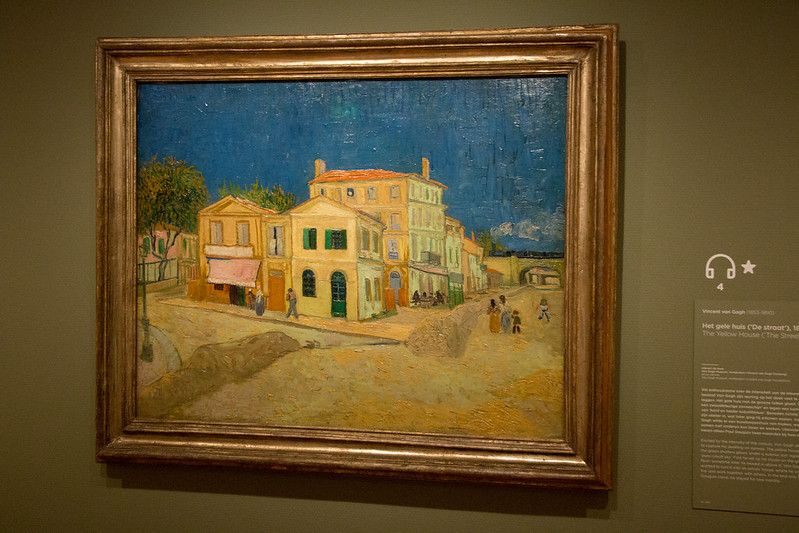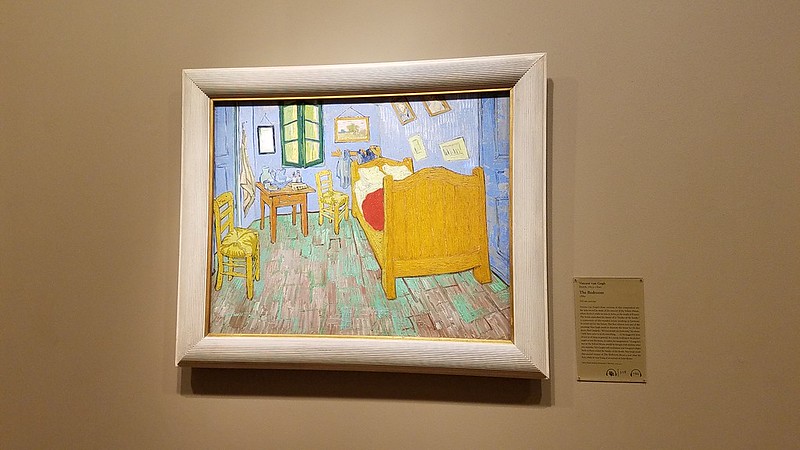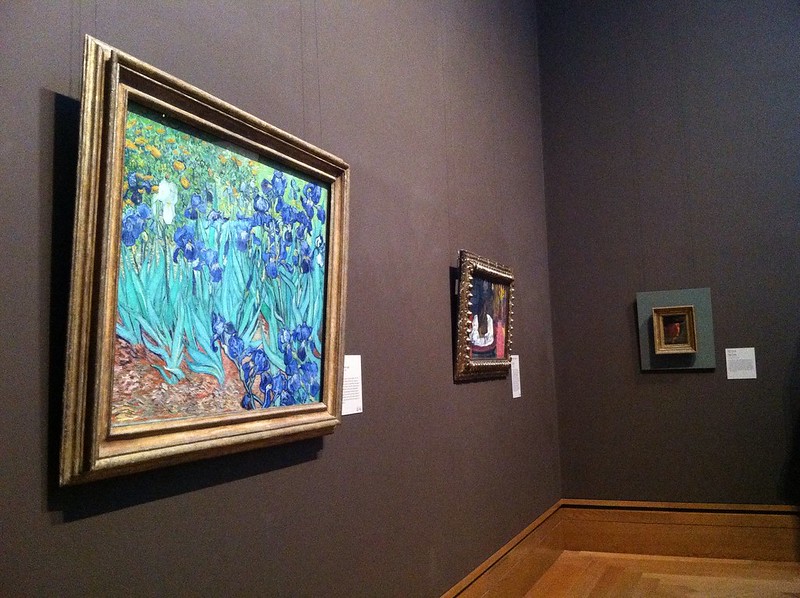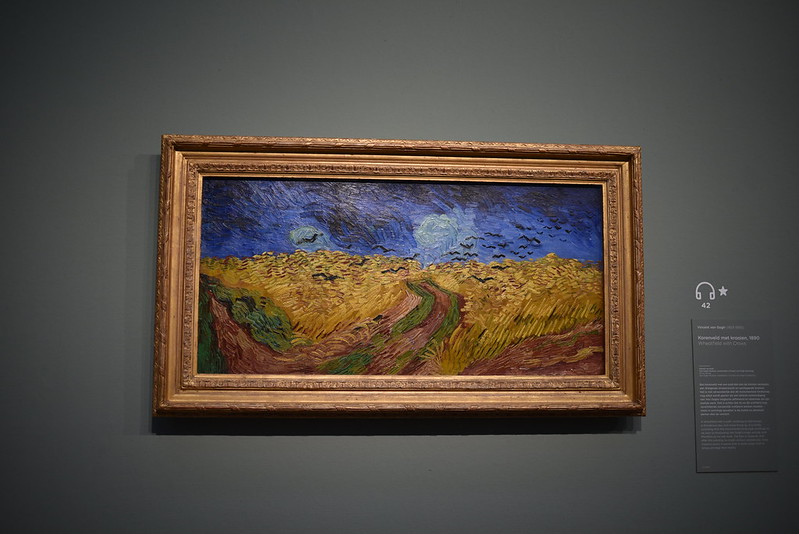Where Is Vincent Van Gogh Art Displayed Where Is Vincent Van Gogh Art

Did you know that Vincent van Gogh didn't make up one's mind to pursue an art career until he was 28 years old? Given the fact that he passed abroad a mere nine years later, information technology's hard to believe that he ultimately created nearly 900 paintings. With and so many works to see, you may be wondering where to brainstorm. Fortunately, we've put together a choice of his about famous paintings—and, nigh chiefly, where in in that location globe you can find them.
Here's where to see ten of the most famous Van Gogh paintings.
Sunflowers – The Metropolitan Museum of Art, New York Metropolis and The National Gallery of Art, London
Van Gogh favored an eclectic assortment of subject matter. In add-on to revealing self-portraits and enchanting dark scenes, he loved painting still-life depictions of sunflowers, which gave him dandy "condolement in contemplating."
Van Gogh completed two series starring sunflowers: Paris Sunflowers (a drove of iv paintings featuring close-upwards studies of cutting sunflowers resting on a flat surface) and Arles Sunflowers (a 5-piece serial showcasing the flowers propped up in vases). While these paintings be in institutions all over the world, you can discover two of the most well-known works at New York City's Metropolitan Museum of Art and London'due south National Gallery of Art.


The Yellow House – The Van Gogh Museum, Amsterdam
Van Gogh lived in Arles, a commune in the South of France, for fourteen months. During this fourth dimension, he had hoped to establish a shared studio where he and his contemporaries could pigment. In an attempt to realize this dream, he rented four rooms in the "Yellow Business firm," a 2-story home located at 2 Place Lamartine.
Unfortunately, the Yellowish Firm was destroyed during World War II. Notwithstanding, in September of 1888, Van Gogh immortalized the charming domicile in a painting, which is now on display at the Van Gogh Museum.

Bedchamber in Arles – The Van Gogh Museum, Amsterdam
While living in the "Yellow House," Van Gogh constitute aplenty artistic inspiration in an unlikely source: his bedroom. Van Gogh painted this subject three times, paying item attention to color in each instance. Upon completing the get-go rendition—which the Van Gogh Foundation has permanently loaned to the Van Gogh Museum in Amsterdam—he described the palette to his brother, Theo, in a letter:
"I take painted the walls pale violet. The basis with checked fabric. The wooden bed and the chairs, yellowish like fresh butter; the sail and the pillows, lemon low-cal greenish. The bedspread, scarlet coloured. The window, green. The washbasin, orangey; the tank, bluish. The doors, lilac. And, that is all. . . I have depicted no type of shade or shadow; I have only applied simple patently colors, like those in crêpes."

Café Terrace at Nighttime – Kröller-Müller Museum, Otterlo
Van Gogh completed many of his almost celebrated paintings while living in the Yellow House, including two honey nightscapes:Café Terrace at Night andStarry Night Over the Rhône.
Café Terrace at Nighttimecaptures a late summer evening in the Place du Forum, a vibrant public square in Arles. To capture the colors of the scene, Van Gogh gear up up an easel in the plaza and painted en plein air. In a alphabetic character to his brother, he explains why he preferred this approach: "I enormously enjoy painting on the spot at dark. In the past they used to draw, and paint the picture from the drawing in the daytime. But I notice that it suits me to paint the affair straightaway . . . it's the only mode of getting away from the conventional black dark with a poor, pallid and whitish light."
This painting is housed by the Kröller-Müller Museum in Otterlo, the netherlands.

Starry Night Over the Rhône – The Musée d'Orsay, Paris
Van Gogh paintedStarry Night Over the Rhône less than one month afterwards completing Café Terrace at Night.Again, he opted to paint outdoors; this time, however, he left the bustling city center behind and settled along the banks of the Rhône River. From here, he could see gas lamps across the water, which echoed the twinkling sight of the stars overheard.
Much like his other nocturnes, Starry Night Over the Rhôneillustrates Van Gogh's inherent interest in color, from the aquamarine sky to the mauve ground. Though luminous tones and energetic brushstrokes fill up the scene with energy, the scene is exceptionally calm—a far weep from the swirling Starry Dark he'd paint the following year.
Today, Starry Dark Over the Rhôneis part of the Musée d'Orsay's permanent collection.

The Starry Night – The Museum of Modernistic Art, New York Metropolis
Van Gogh suffered from mental wellness bug throughout much of his life. Afterward a string of unfortunate incidents (including an episode that resulted in the creative person severing his own ear) in the late 1880s, he checked himself into a mental health facility in the South of French republic. During his time in the asylum, he completed 150 paintings, including The Starry Night,a nocturnal landscape painted through his "iron-barred window."
The Museum of Modern Art in New York Urban center acquired this world-famous painting in 1941.
Irises – J. Paul Getty Museum, Los Angeles
Van Gogh did not permit his institutionalization interfere with his beloved of painting en plein air. Often, he would paint in the asylum'southward garden, where he plant an abundance of plants and flowers, including irises.
In 1889, he painted his almost well-known painting of these flowers. Titled Irises, this painting was most likely intended as a elementary study. However, in 1987, this unassuming work became the most expensive painting ever when it was sold to a private collector for $53.9 meg. Two years later, it was purchased by the J. Paul Getty Museum, where information technology remains today.

Self-Portrait – The Musée d'Orsay, Paris
Prior to his time in the mental hospital, Van Gogh began exploring the cocky-portrait genre. From 1886 until 1889, he completed 30 paintings of himself, including one particularly well-known work at the Musée d'Orsay.
Completed during his time in the asylum, this poignant painting hints toward Van Gogh'due south deteriorating mental state. In addition to outfitting himself with "green-rimmed optics," this arroyo is evident in the artist's treatment of color: a "mix of absinth green and stake turquoise [that] finds a counterpoint in its complementary colour, the fiery orangish of the bristles and hair."
Van Gogh passed abroad a year after completing this portrait.

Wheatfield with Crows – The Van Gogh Museum, Amsterdam
Two months before his untimely death, Van Gogh left the hospital and moved to Auvers-sur-Oise, a suburb of Paris. Though his piece of work began to receive recognition during this time, he suffered some fiscal setbacks that undoubtedly contributed to his poor mental health.
On July 27, 1890, he shot himself in a wheat field—the setting of his painting, Wheatfield with Crows, a piece held past the Van Gogh Museum. Fittingly, this would be the last painting completed past Van Gogh, who died two days after his suicide attempt.

Of course, with over 850 paintings in his oeuvre, this selection merely scratches the surface of Van Gogh'south must-come across paintings. Even so, these x pieces are especially of import, as studying them allows usa to both appreciate his artistic skills and trace the story of his tragic life.
Related Articles:
This Exhibit Gives Visitors the Feel of Stepping Inside Van Gogh's Paintings
Handmade Candles Capture the Enchanting Glow of Van Gogh'southward Famous Paintings
Van Gogh Museum Puts Nearly ane,000 Paintings and Drawings Online
Source: https://mymodernmet.com/where-to-see-van-gogh-paintings/
0 Response to "Where Is Vincent Van Gogh Art Displayed Where Is Vincent Van Gogh Art"
Post a Comment